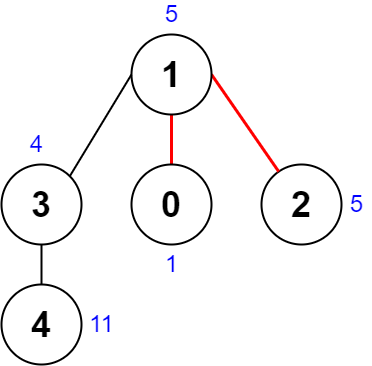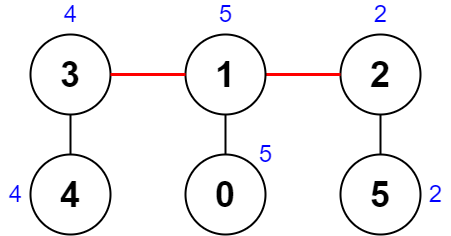2322. Minimum Score After Removals on a Tree
Description
There is an undirected connected tree with n nodes labeled from 0 to n - 1 and n - 1 edges.
You are given a 0-indexed integer array nums of length n where nums[i] represents the value of the ith node. You are also given a 2D integer array edges of length n - 1 where edges[i] = [ai, bi] indicates that there is an edge between nodes ai and bi in the tree.
Remove two distinct edges of the tree to form three connected components. For a pair of removed edges, the following steps are defined:
- Get the XOR of all the values of the nodes for each of the three components respectively.
- The difference between the largest XOR value and the smallest XOR value is the score of the pair.
- For example, say the three components have the node values:
[4,5,7],[1,9], and[3,3,3]. The three XOR values are4 ^ 5 ^ 7 = 6,1 ^ 9 = 8, and3 ^ 3 ^ 3 = 3. The largest XOR value is8and the smallest XOR value is3. The score is then8 - 3 = 5.
Return the minimum score of any possible pair of edge removals on the given tree.
Example 1:

Input: nums = [1,5,5,4,11], edges = [[0,1],[1,2],[1,3],[3,4]] Output: 9 Explanation: The diagram above shows a way to make a pair of removals. - The 1st component has nodes [1,3,4] with values [5,4,11]. Its XOR value is 5 ^ 4 ^ 11 = 10. - The 2nd component has node [0] with value [1]. Its XOR value is 1 = 1. - The 3rd component has node [2] with value [5]. Its XOR value is 5 = 5. The score is the difference between the largest and smallest XOR value which is 10 - 1 = 9. It can be shown that no other pair of removals will obtain a smaller score than 9.
Example 2:

Input: nums = [5,5,2,4,4,2], edges = [[0,1],[1,2],[5,2],[4,3],[1,3]] Output: 0 Explanation: The diagram above shows a way to make a pair of removals. - The 1st component has nodes [3,4] with values [4,4]. Its XOR value is 4 ^ 4 = 0. - The 2nd component has nodes [1,0] with values [5,5]. Its XOR value is 5 ^ 5 = 0. - The 3rd component has nodes [2,5] with values [2,2]. Its XOR value is 2 ^ 2 = 0. The score is the difference between the largest and smallest XOR value which is 0 - 0 = 0. We cannot obtain a smaller score than 0.
Constraints:
n == nums.length3 <= n <= 10001 <= nums[i] <= 108edges.length == n - 1edges[i].length == 20 <= ai, bi < nai != biedgesrepresents a valid tree.
Solutions
Solution: Depth-First Search
- Time complexity: O(n2)
- Space complexity: O(n2)
JavaScript
js
/**
* @param {number[]} nums
* @param {number[][]} edges
* @return {number}
*/
const minimumScore = function (nums, edges) {
const n = nums.length;
const tree = Array.from({ length: n }, () => []);
const children = Array.from({ length: n }, (_, index) => new Set([index]));
const xors = nums.reduce((result, num) => result ^ num, 0);
const subXors = [...nums];
let result = Number.MAX_SAFE_INTEGER;
for (const [a, b] of edges) {
tree[a].push(b);
tree[b].push(a);
}
const dfsTree = (node, prev) => {
for (const neighbor of tree[node]) {
if (neighbor === prev) continue;
const [neighborXor, neighborChildren] = dfsTree(neighbor, node);
subXors[node] ^= neighborXor;
for (const child of neighborChildren) {
children[node].add(child);
}
}
return [subXors[node], children[node]];
};
dfsTree(0, -1);
for (let edgeA = 1; edgeA < n - 1; edgeA++) {
let [a, b] = edges[edgeA];
if (children[a].has(b)) {
[a, b] = [b, a];
}
for (let edgeB = 0; edgeB < edgeA; edgeB++) {
const candidates = [];
let [c, d] = edges[edgeB];
if (children[c].has(d)) {
[c, d] = [d, c];
}
if (a !== c && children[a].has(c)) {
candidates.push(subXors[c], subXors[a] ^ subXors[c], xors ^ subXors[a]);
} else if (a !== c && children[c].has(a)) {
candidates.push(subXors[a], subXors[c] ^ subXors[a], xors ^ subXors[c]);
} else {
candidates.push(subXors[a], subXors[c], xors ^ subXors[a] ^ subXors[c]);
}
const minXor = Math.min(...candidates);
const maxXor = Math.max(...candidates);
result = Math.min(maxXor - minXor, result);
}
}
return result;
};